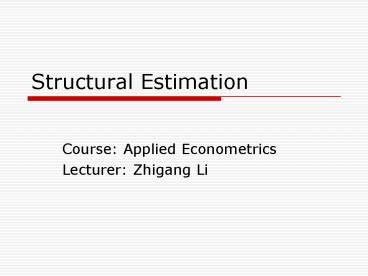Structural Estimation - PowerPoint PPT Presentation
1 / 17
Title:
Structural Estimation
Description:
Unlike the VAR econometricians, the calibrators focus on a few main correlations ... Simple data summary (in contrast to VAR School) ... – PowerPoint PPT presentation
Number of Views:29
Avg rating:3.0/5.0
Title: Structural Estimation
1
Structural Estimation
- Course Applied Econometrics
- Lecturer Zhigang Li
2
Econometric Policy Evaluation
- The goals of econometric policy evaluation are
- To consider the causal impact of policy
interventions on the economy - To compute their consequences for economic
welfare - To forecast the effects of new policies
- Fit or Interpret?
3
Evolution of Causal Inference Fit or Interpret?
(Heckman, 2000)
- The Cowles Commission Tradition (1940s)
- Variant 1 (1970s) Still structural but smaller
- Variant 2 (1970s) VAR Time Series
- Variant 3 (1980s) Calibration Movement
- Variant 4 (1980s) Nonparametric approach and
sensitivity analysis - Variant 5 (1980s) Natural experiment
4
The Cowles Commission Tradition
- Correlation does not imply causation, so
knowing correlation is not enough for future
policy design. - Intellectual success
- The concepts of exogenous (external) and
endogenous (internal) variables - The notions of structural parameters
(policy-invariant parameters suggested by
economic theory) - The problem of identification (many theories may
be consistent with the same data). - Empirical failure
- Large scale structural models, which is perceived
as an empirical failure due to unacceptable
identifying (or simplifying) assumptions.
5
New Structural Models Simpler, More Precise, and
Dynamic
- Based on dynamic general equilibrium theory under
uncertainty with more precisely defined
structural (or causal parameters). - E.g. Mincers female labor supply model
- Euler equation estimation method
- Exploit new sources of micro (panel) data (It is
argued that time series variation was too limited
to recover structural parameters) - Findings not well accepted empirically
6
The VAR Time Series ApproachLess Theory and
More Data Description
- Advocate loosely specified economic time-series
models to describe more accurately macro data - Findings hard to interpret and models too
arbitrary
7
Calibration
- Unlike the VAR econometricians, the calibrators
focus on a few main correlations and means and
build explicit models to account for them. - More sophisticated economic models and and less
rigorous econometric estimates of parameters - Reject fit as a goal of empirical economic
models and emphasize interpretability
8
Nonparametric and Sensitivity Analysis
- View that functional forms and distributional
assumptions in conventional structural approaches
as a major source of their lack of credibility. - Identify structural parameters not using explicit
functional forms, or examine the sensitivity of
estimates to different identifying assumptions.
9
Natural Experiment
- Do not impose arbitrary structure onto the data
- Intuitive economic theory and less emphasis on
structural parameters (in contrast to Structural
School) - Simple data summary (in contrast to VAR School)
- Low computation costs (in contrast to Structural
and Nonparametric School) - Stand Alone Feature The absence of structural
frameworks makes it difficult to cumulate
knowledge across studies. Hard to make
counterfactual policy predictions.
10
Dynamics of Automobile Purchases(Eberly 1994)
- Question Why households are slow to adjust their
(durable goods) consumption bundles. - Two theories
- Transaction costs
- Liquidity constraint
11
How to test the theories I?
- If the transaction costs theory is right, the
households should - Purchase their durable stock with its value equal
to a fixed fraction (or the target share) of its
wealth - Allow the durable stock to depreciate until it
reaches a critical share of wealth - Repurchase a new durable good so that the stock
again equals the target share wealth - If the optimal consumption rule is followed,
- ?lnKiß0ß1?Demanderror
12
How to test the theories II?
- If the liquidity constraint theory is right, then
the model should be - ?lnKiß0ß1?Demandß2Yierror
- Here Y measures liquidity constraints.
13
Findings
- Liquidity or transaction costs?
- For the constrained group, liquidity has a
substantial and statistically significant
negative effect on the consumption profile. - For the liquid group, liquidity has a small
negative effect. - Empirical findings indicates that at adjustment
about 13 percent of total wealth should be held
in durables. This would be allowed to drift down
to about 12 percent before adjusting again.
14
Price Discrimination in Broadway Theater (Leslie,
2004)
- Broadway theater refers to all plays and
musicals performed in theaters in the Times
Square region of Manhattan, New York City, with
seating capacities in excess of 499. - The theoretical framework is a utility-based
model of consumer behavior incorporating viewer
characteristics and institutional details of the
Broadway theater industry. - Data consist of price and quantity sold for all
17 ticket categories for all 199 performances of
Seven Guitars.
15
Behavioral Model
- Consumers are presented with a menu of different
ticket options for seeing a play, or not. - Each individual is characterized by income yi and
taste ?i. - The net utility of individual i from product j is
16
Findings I Structural Parameters
- Perceived quality difference in seats
- Median-quality seat is 70 more valuable than
low-quality seat - High-quality seat is over three times more
valuable than low-quality seat - ql1, ql1.69, ql3.33
17
Findings II Counterfactual Experiments and
Welfare Analysis
- Revenue Utility Attendance
- Benchmark 6.27 3.59 907
- Uniform 8.02 3.60 810
- No Booth 6.73 3.58 873































